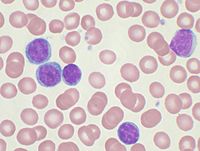
Photo from wikipedia
Dear Editor, I read with interest this clear and thorough study on the immuno‐ phenotypic profile and clinical outcome of monoclonal B‐cell lym‐ phocytosis in kidney transplantation.1 However, I have… Click to show full abstract
Dear Editor, I read with interest this clear and thorough study on the immuno‐ phenotypic profile and clinical outcome of monoclonal B‐cell lym‐ phocytosis in kidney transplantation.1 However, I have a few points to add. In addition to the renal disease in the six cases examined in the study, the presence of concomitant MBL and MGUS is quite remark‐ able. Monoclonal gammopathy of renal significance (MGRS) is a new wide group of kidney diseases defined in 2012, whose pathogenesis depends on monoclonal immunoglobulins secreted by a low‐grade lymphoproliferative disorder. Kidney damage occurs as a result of the activity of monoclonal immunoglobulin aggregates or autoanti‐ bodies produced by a B‐cell or plasma cell clone that can disrupt any nephron region. It may clinically present as any of the classical ne‐ phrological syndromes. It is associated with increased morbidity and mortality, including recurrence in post‐renal transplant. Successful treatment is based on chemotherapy against the underlying clone and renal function.2,3 Given this, all cases of renal insufficiency should be screened for monoclonal gammopathy by serum and urine protein electropho‐ resis, immunofixation and FLC immunoassay, especially in cases in which renal transplant is planned. Renal biopsy is crucial for diagnos‐ ing MGRS, and the differential diagnosis is difficult. Usually, conven‐ tional methods are insufficient, and detailed immunofluorescence and electron microscopic studies are needed.4 The renal biopsy specimen should be evaluated by experienced nephro pathologists who are familiar with MGRS. It should also be kept in mind that in these cases, renal disease may develop as the first manifestation of an underlying lymphoproliferative disorder. I hope that these comments might add to the value of the well‐ written article by Alfano et al.1
Journal Title: Clinical Transplantation
Year Published: 2018
Link to full text (if available)
Share on Social Media: Sign Up to like & get
recommendations!